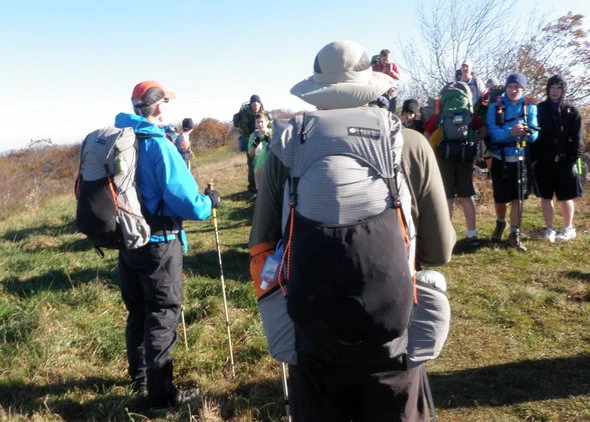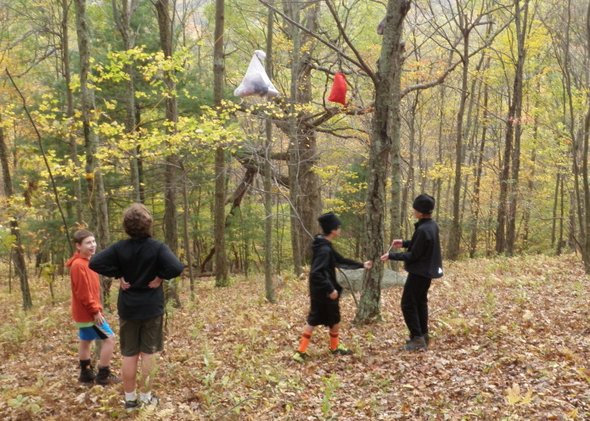
The Five Gallon Pack Challenge
As Scout Leaders for more than a decade, Lee Fields and I have made it our mission to encourage Scouts to participate in backpacking trips. Over the years we have noticed a general reluctance from beginners (and their parents) to take the first "steps", which unfortunately denies these young men the valuable lessons that the trail can teach. Their reluctance typically comes from a lack of gear, a lack of knowledge, and a general fear of the unknown. So if the end goal is a life-long love of backpacking, how do you take down entry barriers and get their boots on the trail?
To be fair, there are many Scouting programs that have first year Scouts (11-12 years of age) successfully engaging in backpacking trips with older Scouts, but over the years we have found that this model didn't work for our Troop. Our experience has been that young Scouts are typically under-sized and over-packed, with the result that most come home feeling like they survived the trip rather than enjoyed it. Younger Scouts also typically can't keep the pace of older Scouts and adults, adding to their frustration. In response we developed our Troop's "backpacking experience" trips, where the youngest and smallest Scouts participate in building skills they can use on later trips, and the second-year and older inexperienced backpackers participate in a backcountry trip designed specifically for their skill level.

Ken and Lee talking with the backpacking group on the bald at Cole Mountain.
For most of the month of October we participated in meetings to discuss topic such as lightening weight backpacking, successful backcountry cooking plans, water treatment and the dreaded "how to go in the woods" talk. Scouts had an opportunity to practice basic skills such as bear bag hanging, and the week before the trip participated in a "shakedown" where they brought in their backpacks and had them reviewed by a leader for suggestions on how to lighten their load. Almost all had packs weighing in the 20-30 pound range.

Both groups camp at the meadow
Our younger Scouts would be day hiking out of basecamp on the trip but were asked to simulate the experience of a backcountry trip by cooking on backpacking stoves, filtering water and lightening gear to the greatest degree possible. One target we gave them was the "5 gallon challenge"- to pack their gear in something that approximates the size of a 5 gallon bucket. Most were able to come close when we allowed them to have the tent and sleeping bag remain "outside" the bucket. The mission was to get them to think about every item they were taking, which we hoped would open the door to lighter packs in the future.
Another reality is the lack of gear. To help alleviate the "it costs too much" excuse our Troop has invested over the last few years in gravity filters, backpacking stoves and several lighter two-man tents. Scouts and adults are able to check out the gear from the Troop to use for the trip to see what works for them. We also have a number of older donated backpacks but hope to invest in lighter packs in Scout sizes in the future.

Views from the top of Cole Mountain
At the end of October the Troop departed for their trip to the Mt. Pleasant Recreation area near Amherst, VA. If you could design a perfect location for this trip it would probably look very much like Mt. Pleasant. In addition to a large meadow at the Appalachian Trail crossing of Hog Camp Gap, Mt. Pleasant offers fairlyhance to experience the amazing scenery at the bald on Cole Mountain.
Unlike the longer backpacking trips our older Scouts typically take, this outing was designed specifically to give our younger Scouts a challenge they could handle successfully. Both groups spent the first night together at Hog Camp Gap. On Saturday morning, they got their first chance to cook dehydrated "freezer bag" meals on backpacking stoves, and then the backpacking group left for an overnight camp in the backcountry. The younger group hiked one of the two loops as a dayhike and returned to the meadow on Saturday, allowing each Scout to take as much or as little gear as they felt comfortable carrying.

One of the crews heads north on the AT across the bald
The older Scouts first took on the Mt. Pleasant/Henry Lanum loop. About two miles in a few Scouts discovered that the pack that seemed to fit well in the parking lot had started to pinch and was in need of adjustment. Several began rethinking a few of the "must have" items they carried whose weight no longer seemed worth it. We have two favorite sayings "everything is lighter in the parking lot" and "fear is the heaviest thing you can pack"- but there are some things you just have to experience to understand.
The Henry Lanum trail climbs to an overview and a few of our Scouts struggled as the trail became steeper. This is a common occurrence with Scouts and it is interesting that the Scout that is struggling today may be fine on the next trip- or even tomorrow! Lee and I walk as "sweeper" to make sure that we are always behind the slowest Scout or adult to encourage and motivate them, and to make sure everyone stays with the group. hen started up a long fairly gentle climb on the "Old Hotel Loop" that leads to the Cow Camp Gap AT shelter- our stopping place for the night. Our Troop does not use shelters and tries to avoid camping too close to them to avoid bothering long distance hikers who may have a different idea of hiker midnight than our Scouts. This shelter has a large camping area out of earshot, with a nice water source which was perfect for our group.

Scouts review their bear bag attempts with older scouts and get suggestions on better placement.
Scouts set up camp and started camp chores like collecting water. Everyone tried their hand at hanging bear bags and the first-timers discovered it was much easier than it looks. Several Scouts had multiple opportunities to hang a bag as their efforts were reviewed and critiqued by older and more experienced Scouts. Finally dinner was cooked, and everyone settled in for the night.
The next morning was near freezing with a stiff wind, but the new backpackers managed to successfully get their gear repacked and headed up the trail to Cole Mountain. The view from the top is one of my favorite in Virginia, and it was great to see the look on the Scouts faces when they came out of the woods to the 360 degree views of Fall Color.
After a short hike back to basecamp, we spent a few minutes reviewing with the Scouts lessons that could help them on the next trip. We always suggest that they make a pile at home of any gear that they did not use on the trip, and think through whether they needed to take it on future events. We also suggested they remember what gear that other Scouts and leaders carried that was lighter or seemed like a better choice for backpacking, and put it on their holiday lists!

Lee at blaze- walking "sweeper" to make sure everyone stays with the group.
So do these trips work to encourage backpacking as the Scouts get older? We think so. First year scouts are often heard to say "next year when I can go backpacking" and our first-time backpackers often ask about the next trip, which is a big change. Our Scouts totally control their annual outing plans and now include backpacking events several times a year. In addition to short weekend trips, we typically take the older scouts on 4-5 day trips at Spring Break and a number of our Scouts have participated in Council trips to Philmont. Perhaps the nicest reward is when one of our Scouts who had aged out of the program calls for advice on a trip he is planning with college friends. If the goal was to kindle a fire for backpacking, we believe that many are on their way.
This post was written by former Trail Ambassadors Ken Holder and Lee Fields.
